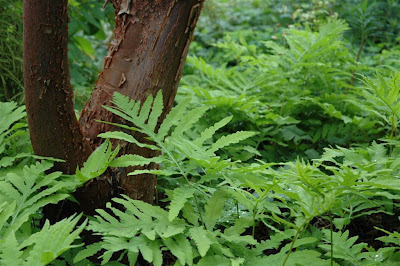

The steel factory was abandoned in 1985, leaving behind an assortment of monstrous structures and polluted soil. The transformation into a public park was initiated in 1991, and was carried out by landscape architect Peter Latz, of the firm Latz + Partner. Unlike other proposals that were made for the site, his aimed to keep most of the existing buildings, and use them to illustrate and understand the industrial past rather than cover it up. As a result, everything has been left in place: the gigantic factory buildings, concrete storage bunkers of mammoth proportions, pools and canals, and the old railway. But everything has been put to new and often unexpected usage.
The factory buildings themselves provide the dominant theme for the park. They are in a perfect state of romantic dilapidation – rusted, cracking at the joints, and with signs of nature’s reclamation sprouting up everywhere. Access is allowed into several buildings through narrow and steep stairways that lead to a labyrinth of dark walkways. A little unsettling to a North American used to overly tight safety regulations. The edgy industrial feel of these buildings seemed to appeal to two groups in particular: teenage rock bands looking for a backdrop for their bad-boy cover shots, and well-equipped amateur photographers. You could find plenty of both hidden in the most unexpected dark recesses of the buildings.


 The great concrete bunkers and various concrete storage structures that surround the factory buildings were also left in place. They are now put to creative use either as playgrounds featuring gigantic sand boxes and twisting slides, or as climbing walls. As a climber myself, the latter was really nice to see. And very tempting since the climbing rope happened to be in the car!
The great concrete bunkers and various concrete storage structures that surround the factory buildings were also left in place. They are now put to creative use either as playgrounds featuring gigantic sand boxes and twisting slides, or as climbing walls. As a climber myself, the latter was really nice to see. And very tempting since the climbing rope happened to be in the car!

All this is well enough, but what about the green stuff that usually goes in parks? I think Richardson already described the approach perfectly when he said the “lightest of touches” was used. Most of the greenery seems to be whatever happens to grow there - it's hard to tell what was planted and what was already found growing at the abandoned site. There are a few exceptions, such a simple geometric planting of trees at the entrance to the park, and some pruned hedges here and there to punctuate the chaos. The soil was quite polluted, but Latz chose not to replace it. Instead, the very fancy-sounding approach of “phytomediation” was taken, meaning that the soil was left in place and plants are now used to do the rehabilitation work. Perhaps what seemed like a mess of random vegetation is actually a carefully chosen mix of soil detoxifying plants?



The only more ‘gardened’ area, if one can call it that, is across from the factory buildings on the other side of the canal. Here, there are a series of gigantic concrete bunkers, which look like boxes with no tops. There is an elevated walkway which allows visitors to look into the boxes from above. Given the viewpoint, the planting patterns are kept simple and obvious. Several boxes are planted with straight rows of identical plants, which I thought worked quite well. In one box, the only one you can actually walk into, tightly clipped hedges were used to create a strong geometric pattern which was both striking from above and effective below. Although the hedge pattern is not classical, the garden contained mostly traditional plants, such as roses and hydrangeas.





The Duisburg Landschaftspark is certainly a very interesting experiment, and a park unlike any I have seen before. But personally, the feeling I got walking through it was one of uneasiness, of being on edge. There is no sugar coating the industrial history here, no softening of the landscape with pretty plantings. Certainly many elements are original and may provide important inspiration for the future. But to me, it felt a bit like a very modern house – nice to see and visit, but just not comfortable to live in.






































